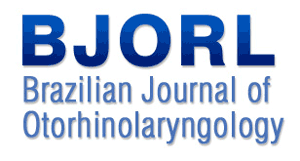Introduction:
Endoscopic endonasal transsphenoidal surgery has gained increasing acceptance by otolaryngologists and neurosurgeons. In many centers throughout the world, this technique is now routinely used for the same indications as conventional microsurgical technique for pituitary tumors.
Objective:
To present a surgical experience of consecutive endoscopic endonasal trans-sphenoidal resections of pituitary adenomas.
Methods:
In this study, consecutive patients with pituitary adenomas submitted to endoscopic endonasal pituitary surgery were evaluated regarding the rate of residual tumor, functional remission, symptoms relief, complications, and tumor size.
Results:
Forty-seven consecutive patients were evaluated; 17 had functioning adenomas, seven had GH producing tumors, five had Cushing's disease, and five had prolactinomas. Of the functioning adenomas, 12 were macroadenomas and five were microadenomas; 30 cases were non-functioning macroadenomas. Of the patients with functioning adenomas, 87% improved. 85% of the patients with visual deficits related to optic nerve compression progressed over time. Most of the patients with complaints of headaches improved (76%). Surgical complications occurred in 10% of patients, which included with two carotid lesions, two cerebrospinal fluid leaks, and one death of a patient with a previous history of complications.
Conclusion:
Endoscopic endonasal pituitary surgery is a feasible technique, yielding good surgical and functional outcomes, and low morbidity.
Pituitary neoplasms; Natural orifice endoscopic surgery; Pituitary gland; Video-assisted surgery; Sella turcica
